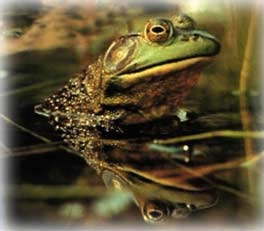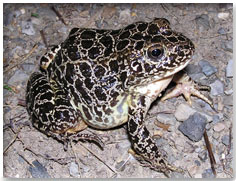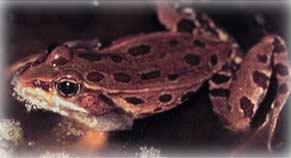Indiana Frogs and Toads
Note: Little of the content, below, is original. Most was gleaned from the Indiana DNR website or the one day FrogWatch classes we took.
- American Toad
- Blanchards Cricket Frog
- Bullfrog
- Crawfish Frog
- Green Frog
- Northern Leopard Frog
- Pickerel Frog
American Toad

DESCRIPTION
2" - 3.5" (5.1 - 9.0 cm). Brown to gray to reddish or olive, may be ornamented by patches of yellow or buff, only one or two large warts in each of the largest dark spots, chest and forward part of abdomen usually spotted with dark pigment, enlarged warts on tibia, parotoid gland either separated from the ridge behind the eye or connected with it by a short spur, can inflate vocal sacs. Light middorsal stripe may be present.
CALL DESCRIPTION
A long (30 seconds) high-pitched musical trill. Male's vocal sac is round when inflated.
INDIANA RANGE
Throughout Indiana with exception of the lower Wabash valley.
DIET
Eats insects and insect larvae, spiders, beetles, ants, centipedes, millipedes, snails, slugs and earthworms.
HABITAT
Common in variety of habitats wherever there are insects, moisture, and a variety of shallow waters for breeding; suburban backyards, forests, meadows.
BREEDING HABITAT
Temporary wetlands, swamps, shallow bays or lakes and backwaters of rivers, streams and ditches.
BREEDING SEASON
late March - late June
EGGS
Deposited in long, double strings that may stretch for several feet in the shallow edges of ponds. Female lays up to 20,000 eggs which normally hatch within one week.
TADPOLES
Tiny, dark; attach underwater to vegetation, large schools feed together along the edge of shallow wetlands, emerging as a mass of tiny toads within approximately six weeks. Maturity occurs in 2-3 years.
Blanchard's Cricket Frog

DESCRIPTION
5/8" - 1-1/2" (1.6 - 3.8 cm) Wartier, heavier and bulkier than other cricket frogs. Dark stripe on thigh blending with dark pigment above and in the anal region. Usually shades of light brown with gray and green speckles, a tendency toward uniformity. Snout rounded, legs relatively short, heavy webbing of hind foot reaching tip of first toe and next to last joint of longest toe, toe pads are absent. Diurnal. Males have a single yellowish vocal pouch under the chin, dark triangle between eyes, often a bright green or reddish stripe on back.
CALL DESCRIPTION
Gick-Gick-Gick. Like two steel balls clicked together, slowly at first, picking up speed until a continuous rattle then decreasing, continuing for 20-30 or more beats. Males call day and night from the bank or from mats of floating vegetation.
INDIANA RANGE
Nearly every county in Indiana, has become rare in northern quarter of state during the last 25 years.
DIET
Eats a variety of terrestrial and aquatic insects and other invertebrates including beetles, water boatmen, midge larvae and spiders.
HABITAT
Sunny pond of shallow water with good growth of vegetation in water or on shore, slow moving streams with sunny banks, also found on the sandy gravel or muddy bars and banks of small sluggish streams.
BREEDING HABITAT
Temporary wetlands, swamps, shallow bays or lakes and backwaters of rivers, streams and ditches.
BREEDING SEASON
Prefers to breed in wetlands and streams with adjacent mudflats and abundant emergent vegetation.
EGGS
Attached to submerged objects and vegetation singly or in small clusters. One female can lay 200 eggs in surface clusters of 10-15 eggs each.
TADPOLES
Bottom dwelling and secretive, dark tail tip. Becomes mature within one year.
Bullfrog

DESCRIPTION
3-1/2" - 6" (9 - 15.2 cm) Plain green (sometimes brown, yellow or albino) with dark markings, no dorsolateral ridges on the back, ridge of skin begins behind eye running over eardrum ending at the base of the front leg, smooth skin, webbing does not reach end of toes, large external eardrum, hind feet fully webbed except for last joint of longest toe, belly cream colored. Have pouches to make throat and sides of body expand to give illusion of larger size.
CALL DESCRIPTION
Deep bass notes similar to a foghorn or like drawing a bow across a bass fiddle; can be heard for 1/4 mile.
INDIANA RANGE
Throughout Indiana
DIET
Opportunistic. Will eat almost anything including fish, other frogs, snakes, turtles, birds and small mammals.
HABITAT
Ponds, lakes and slow-moving permanent streams with vegetation for cover.
BREEDING HABITAT
Breeding occurs in permanent bodies of water.
BREEDING SEASON
mid-May - end of July
EGGS
Deposited in huge, semi-floating masses that look like mats of frothy tiny bubbles. One female may lay up to 20,000 eggs. Mass may be two feet in diameter and hatches within a week. Masses are attached to submerged vegetation.
TADPOLES
Olive green, underneath white or cream colored. May take two years to transform and reaches maturity within three years.
Crawfish Frog

Description
2 1/4-4 ½” (5.7-11.4cm). Large and stubby body with distinct humped lower back when at rest. Irregular dark spots crowded together and surrounded by light borders. Belly white without spots.
Call Description
Loud, deep, resonant snore repeated at irregular intervals. Large choruses sound like hogs at feeding time.
Indiana Range
Southwestern and west-central Indiana. Isolated population in the southeast region. Very uncommon. Endangered in Indiana.
Diet
Nocturnal beetles, crayfish, small amphibians and reptiles.
Habitat
Low, wet areas including moist meadows, prairies, woodlands, and brushy fields. Can be found in crawfish holes.
Breeding Habitat
Flooded fields, fish-free ponds, and small lakes.
Breeding Season
Mid-March to mid-April
Eggs
Masses of 3,000 - 7,000 eggs attached to vegetation.
Tadpoles
Grayish brown to greenish with small black dots on body and tail. Belly is whitish with internal organs faintly visible through skin. Similar to green frog and bullfrog, but has more dark pigment on mouth.
Green Frog

Description
2.25 - 3.5 inches (5.7-9cm). Light olive brown to dark olive green. Dorsolateral folds (ridges) extend from eye to groin. Large external eardrum that is larger than eye in males and same size in females. Large head, blunt snout, small warts, and long legs. Webbing on toes extends to tips on all but fourth toe. During breeding season, males develop bright yellow throat.
Call Description
Low pitched twanging that sounds like a plucked banjo string or a tight rubber band. Sometimes doubled and repeated at irregular intervals.
Indiana Range
Statewide
Diet
Eats aquatic and terrestrial insects and other invertebrates including beetles, flies, butterflies, caterpillars, grasshoppers, spiders, slugs, snails, crayfish, millipedes.
Habitat
Permanent bodies of water, slow sections of streams. Avoids warm, muddy, or transient bodies of water.
Breeding Habitat
Permanent bodies of water.
Breeding Season
May - Aug
Eggs
Laid in a mass of 1,000-5,000 in a thin film that touches the surface of the water.
Tadpoles
3-4 inches total length, yellowish brown to olive green with black flecks and a creamy colored belly. Plump with long tail and high fins. Similar to bullfrog tadpole. Most will overwinter the first year and transform the following summer. Mature approximately one year after metamorphosis.
Northern Leopard Frog

Description
2-3” (5.1-9cm). Dark spots on back with white margins. Spots mostly larger than eye. Dark spot on snout, no spot on external eardrum. Green, tan, or brown with a white belly. Dorsolateral ridge extends to groin. Slender with a narrow head.
Call Description
Deep rattling snore that lasts 2-3 seconds, followed by a chuckling sound, like a heavy creaking door slowly opening. Also sounds like two balloons being rubbed together. Difficult to distinguish from southern leopard frog unless heard on the same night.
Indiana Range
Northern, central, and extreme southeastern Indiana. This is a Species of Special Concern.
Diet
Eats terrestrial invertebrates such as insects and insect larvae, spiders, slugs, snails and earthworms. Large adults also eat other frogs.
Habitat
Marshes, bogs, moist fields, lakes, streams, and ponds surrounded by wet meadows.
Breeding Habitat
Marshes, wetlands, fishless ponds, and roadside ditches.
Breeding Season
Mid-March to May
Eggs
Females may deposit 3,000-5,000 eggs in globular clusters. Usually laid in shallow water and attached to submerged vegetation a few inches below the surface of the water. Hatch in 1-2 weeks.
Tadpoles
Olive brown to green with dark spots. Belly iridescent with visible internal organs. Tail lighter than body, transparent tail fins with dark lines.
Pickerel Frog

Description
1 - 3” (4.4-7.5cm). Square black spots in two rows down the back, in between both dorsolateral ridges. Ridges occur from eye to hip uninterrupted. Undersides of thighs bright yellow. Gray or tan with a white belly.
Call Description
Low-pitched, steady snore with little carrying power. 1- 2 seconds in duration. Similar to leopard frog, but more regular.
Indiana Range
Statewide except northwestern prairie and lower Wabash valley. Not common.
Diet
Insects, spiders, worms, and insect larvae.
Habitat
Wet areas with vegetation including streams, spring-fed lakes, farm ponds, meadows, and swamps.
Breeding Habitat
Marshes, wetlands, fishless ponds, and roadside ditches.
Breeding Season
April to May
Eggs
Globular mass of 700 – 2,900 eggs attached to submerged vegetation.
Tadpoles
Olive brown to green with dark spots. Belly iridescent with visible internal organs. Tail lighter than body, transparent tail fins with dark lines.